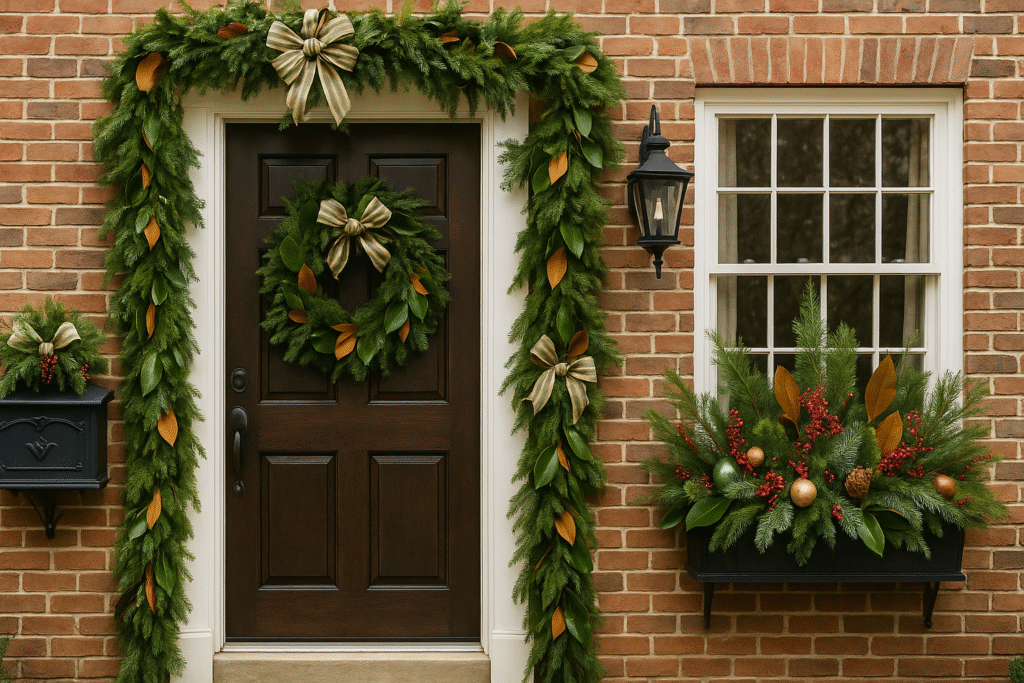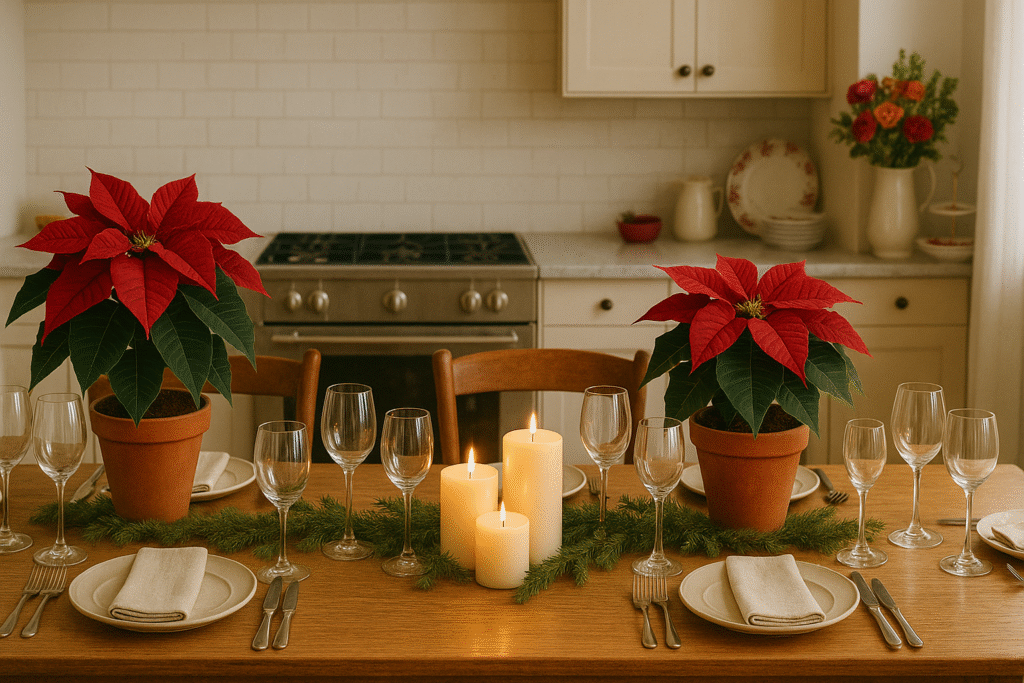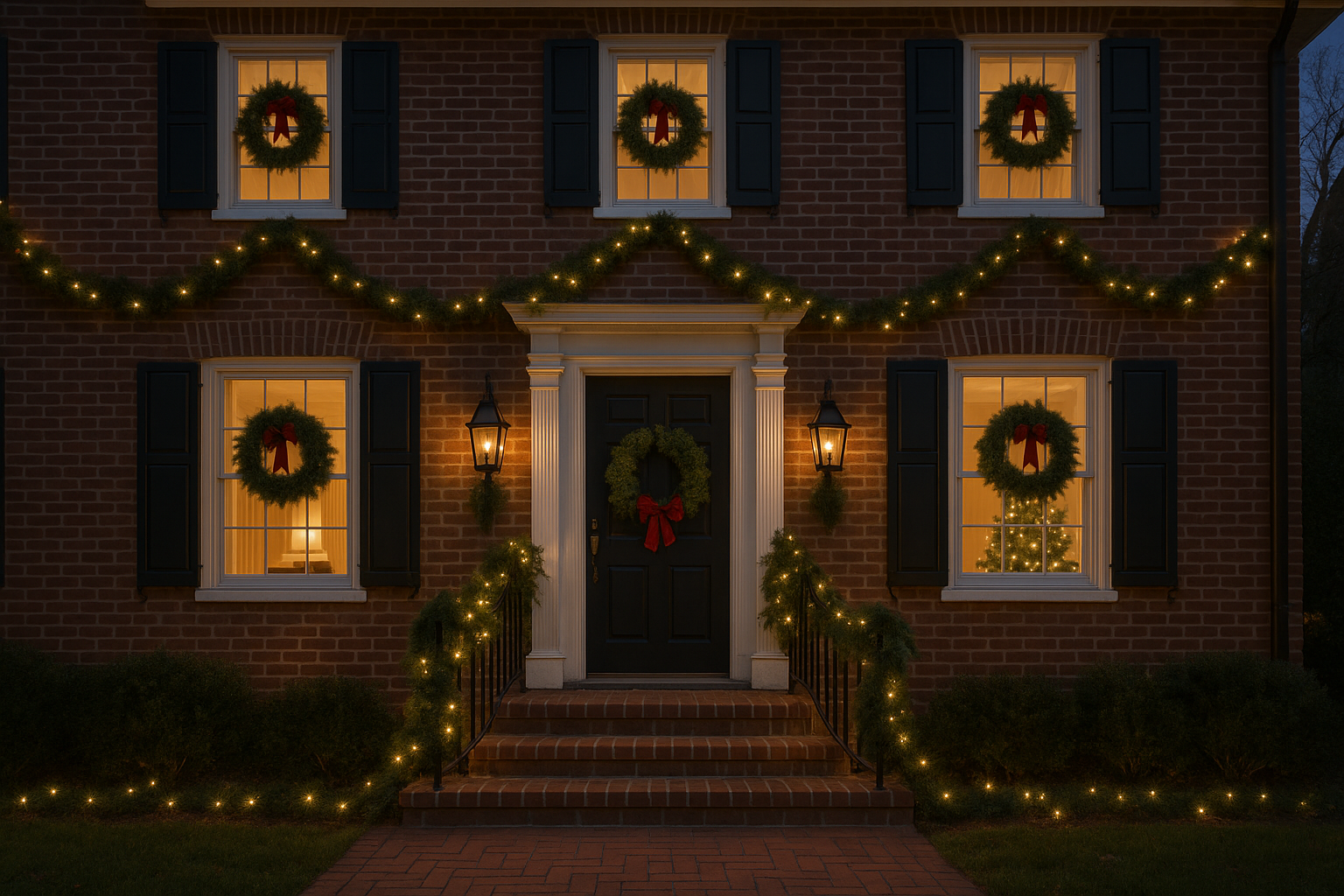Seasonal decorating can influence how a home is experienced before guests even walk through the door. The mailbox, the garden gate, the entryway, and the rooms where people gather can all be styled with choices that feel deliberate and connected. Decorations that combine natural greenery with handmade pieces give each space a welcoming character and create continuity across the home.
The approach does not need to be complex. A unified palette that relates to the structure of the house keeps the presentation consistent. A house with pale brick, dark shutters, and copper fixtures, for example, is complemented best by greenery and accents that echo those same colors. When decoration highlights features already present, the setting feels festive and coordinated with its surroundings.
Seasonal Greenery for the Exterior

Evergreen branches have been part of seasonal decoration for centuries, shaped into garlands and wreaths that signal endurance through the colder months. Their appearance at the start of the season sets a familiar foundation that is both practical and decorative. A garland made with mixed evergreens can be adapted for local traditions. In Southern settings, magnolia leaves are often included, with their deep green surfaces paired against the warm copper tones of the velvety backs. The alternation of colors produces contrast while still keeping the arrangement natural. Olive branches can be added for a lighter texture, and their pale shade introduces a soft accent that brightens the arrangement.
Outdoor displays extend beyond the front door. In many communities, roadside mailboxes are treated as small stages for decoration. Cuttings saved from the base of a Christmas tree provide material for this purpose. When combined with berries, fruit, or pinecones, the arrangement is tied together with ribbon to announce the season before guests even arrive at the house.
Window boxes are another feature that benefits from attention. Instead of leaving them empty after the growing season, they can be replanted with hardy shrubs. A covering of reindeer moss provides a base, and simple additions such as metallic stars or clipped greenery link the window boxes visually to the garlands and wreaths already in use. These details complete the exterior and keep the presentation consistent from one vantage point to another.
Welcoming Interiors
The entrance of a home establishes the first impression of its interior. Seasonal preparation here involves more than a door wreath. The spaces that open directly from the entry deserve focused attention because they frame the guest’s first view of the house. Instead of spreading decorations thinly throughout every corner, the emphasis is placed on a single feature that can serve as the centerpiece. A mantel or a sideboard, when dressed with greenery and coordinated accents, can provide this focal point and set the stage for the rest of the rooms.
The link between outdoors and indoors is important. When decorations at the entry continue the choices used outside, the result is consistent and easier to manage. A strand of twinkle lights wrapped with metallic garland and ribbon, for example, connects directly to the greenery and color scheme already established outdoors. This repetition provides continuity for visitors as they move from the exterior of the house into the interior.
Dining Spaces Prepared for Celebration

Seasonal gatherings often center around the dining area, where table settings and decorations create an atmosphere suited for meals and conversation. Preparing this space begins with lighting and music that set a background for the event, followed by a table arrangement that balances function and decoration. Candles and coordinated tableware establish the setting and signal that the house is ready for company.
For larger groups, the dining table can be reconfigured from its usual purpose. Turning it into a buffet or cocktail station makes it easier for guests to help themselves and continue mingling throughout the room. This adjustment allows the dining space to serve as both a passage and a destination during an event.
Seasonal plants can be incorporated into the setting as well. Poinsettias, known for their vivid bracts, can be cut and placed in arrangements that last up to two weeks. To prepare them properly, the lower leaves are removed and the stems are set in cool water until the sap clears. When maintained with fresh water, these flowers hold their color and remain a striking feature of the holiday table.
Decorating The Kitchen
The kitchen is often the busiest room during the season, yet it is sometimes overlooked when planning decorations. Preparing it with the same care given to other areas ensures that it feels ready for the gatherings that naturally take place there. Simple adjustments can transform the atmosphere without requiring extensive effort.
Color is one of the quickest ways to introduce a festive note. Bright shades of red, orange, and green, when added through dishware, linens, or small decorative accents, signal the change in season. Swapping everyday items for holiday-themed pieces, hanging a wreath, and introducing fresh greenery are straightforward steps that shift the appearance of the room.
Flowers and arrangements also belong in the kitchen, not just the dining room. Informal settings can support more relaxed choices, such as a rustic planter filled with seasonal stems and clippings. Pairing ranunculus, hydrangeas, berries, and cypress branches produces a display that feels abundant while remaining approachable. A handcrafted ornament or decorative element, placed against a simple backdrop like a neutral backsplash, can serve as a focal point that ties the display together.
By approaching the kitchen with attention to both color and detail, the space becomes more than a workspace. It turns into a setting where guests want to linger and take part in the conversations that unfold while food is prepared.
Packages as Seasonal Displays
Wrapped gifts can serve as another form of decoration. Instead of treating them as a final step, they can be viewed as an extension of the home’s seasonal style. Each package placed under the tree adds to the overall setting, and small adjustments in materials and presentation make the display more distinctive.
Even scraps of leftover wrapping paper can be put to use. Small cutouts made from the remaining pieces add detail to plain boxes. Repurposed ornaments or sections of garland can be tucked under ribbon to create layers of texture. Ribbons themselves do not need to be tied in traditional bows. A simple knot, when combined with greenery or decorative accents, creates a finished look with less effort.
Materials also influence the result. Brown paper, for instance, provides a neutral base that pairs well with burlap or a clipped sprig of boxwood. Tassels or pompoms from a craft store can be fastened to the package as a playful addition. These small choices make the wrapped gifts part of the broader decoration scheme, turning them into visible elements rather than hidden surprises.
Secondary Entrances with Seasonal Details
Not all guests enter through the main front door. Side entrance areas and back doors also contribute to how the home is experienced during the season. These practical spaces can be made inviting with small touches.
A bench or chair placed near the entrance offers a convenient spot for removing boots or setting down parcels. Storage compartments can serve more than a functional role by displaying ornaments, collections, or heirlooms that reflect the household’s seasonal traditions. Even a staircase leading from this area can be decorated. A garland woven with pinecones, fresh greenery, and blue ribbons brings attention to a space that might otherwise be overlooked.
By including these secondary areas in the decorating plan, the home feels more consistent. Every entrance, regardless of its location, reflects the same sense of preparation and welcome as the front door.
Decorating Guest Rooms

Seasonal decorating extends to guest spaces as well. Visitors often value a quiet room where they can retreat from the activity of the holiday. Preparing this area with the same care given to shared spaces ensures that it feels restful while still connected to the larger theme of the home.
Natural greenery can be incorporated here in simple ways. Evergreen branches arranged above the bed or hung as a mobile create a canopy effect. When combined with ornaments, the arrangement draws the eye upward and adds a sense of depth. Layers of pillows and soft bedding reinforce the comfort of the room while balancing the more decorative elements.
Smaller details complete the atmosphere. A bedside table arranged with bottle brush trees, ornaments, and candles provides variety in both color and light. Adding fresh flowers gives the setting a finished touch, especially when the colors coordinate with the overall decoration scheme of the house. These gestures turn the guest room into more than a sleeping space, offering visitors a calm environment within the larger celebration.

Seasonal decoration reaches across the home when each space is considered in relation to the whole. The exterior sets expectations with greenery and accents that guide guests toward the entrance. Inside, a clear focal point at the threshold welcomes visitors and links the outdoor arrangements to the interior. Dining areas and kitchens are adjusted to support gatherings, with flowers, table settings, and casual arrangements that keep people comfortable while they share food and conversation. Details such as wrapped gifts, decorated side entrances, and prepared guest rooms ensure that no corner of the home is neglected.

Season Greetings
Inside Season Greetings, you’ll find inspiration for planning joyful gatherings and decorating a festive home.







